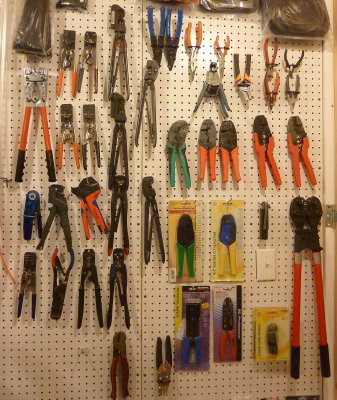As the title says lets put together a model system.
I would like to get all the parts together to be able to do a test system. I would need everything - assume i have nothing. I need test instruments, and crimpers to make cables, strapping gear to strap up a set of 3.2v cells + anything you can think of one should have in a workshop to mess with LFP setups.
Lets say i do a 24v system. That will be 8 x 3.2v Cells, say 100ah. Then i would use an Exeltech XP 600 watt inverter (this is just a small test system to get experience with).
I would want to use mains power to keep the batteries charged. I would also like to use the same system hooked to solar panels - what CC should i use for that - one that can be optimized for LFP use or at least the config setup such that it can charge LFP batteries from solar panels.
What charger would you suggest i use?
What instrumentation could i use to have it talk back to a server (or some such setup) to log data of the system? This is useful if i wanted to put this in my weekend cabin but monitor from home during the week (Internet is available at the cabin) so i can see how much power is in the battery etc.
What else am i missing that i need to think about getting so i can build out, setup and configure LFP systems?
I would like to try a bigger system for full time off grid home use but would like to mess with a few smaller systems first to learn all the in's and outs.
Thanks for any pointers
I would like to get all the parts together to be able to do a test system. I would need everything - assume i have nothing. I need test instruments, and crimpers to make cables, strapping gear to strap up a set of 3.2v cells + anything you can think of one should have in a workshop to mess with LFP setups.
Lets say i do a 24v system. That will be 8 x 3.2v Cells, say 100ah. Then i would use an Exeltech XP 600 watt inverter (this is just a small test system to get experience with).
I would want to use mains power to keep the batteries charged. I would also like to use the same system hooked to solar panels - what CC should i use for that - one that can be optimized for LFP use or at least the config setup such that it can charge LFP batteries from solar panels.
What charger would you suggest i use?
What instrumentation could i use to have it talk back to a server (or some such setup) to log data of the system? This is useful if i wanted to put this in my weekend cabin but monitor from home during the week (Internet is available at the cabin) so i can see how much power is in the battery etc.
What else am i missing that i need to think about getting so i can build out, setup and configure LFP systems?
I would like to try a bigger system for full time off grid home use but would like to mess with a few smaller systems first to learn all the in's and outs.
Thanks for any pointers


Comment